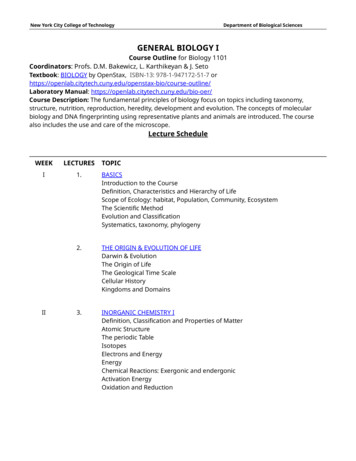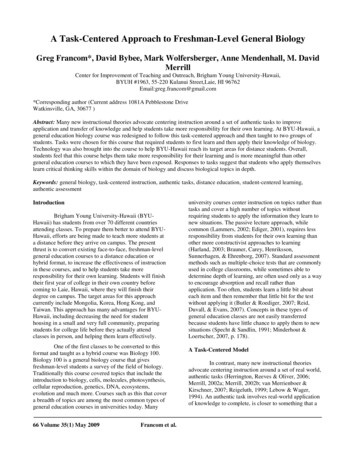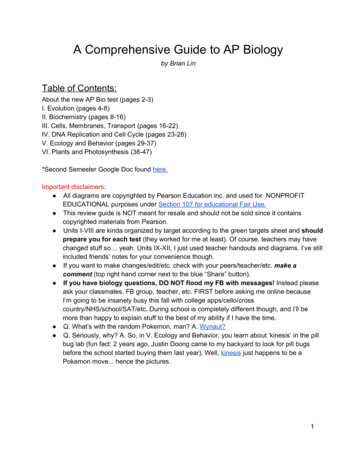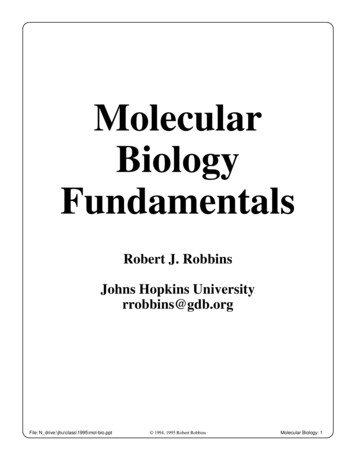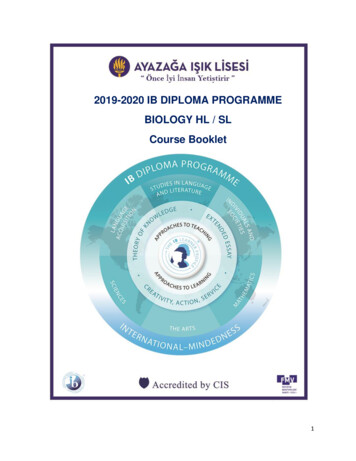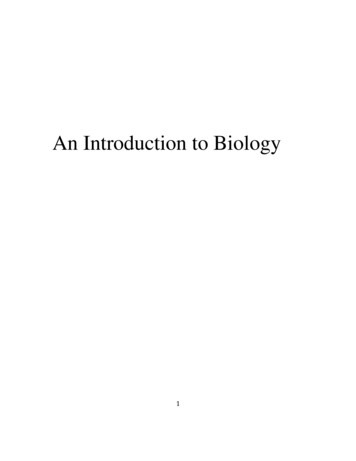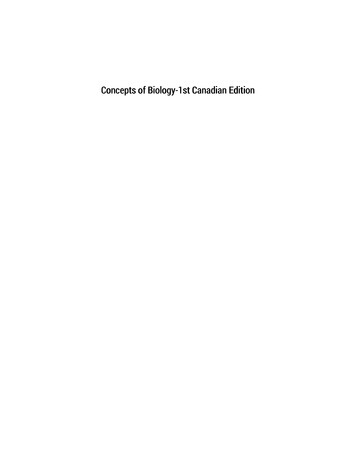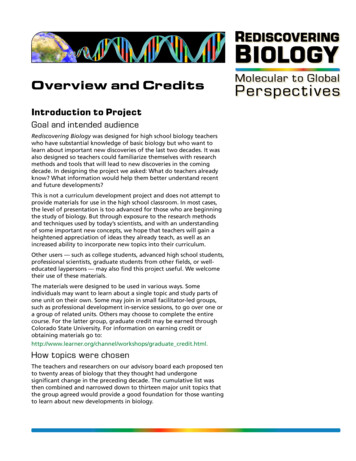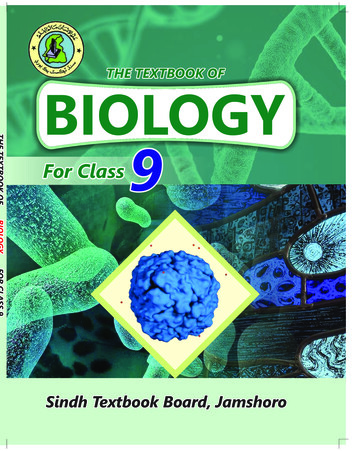
Transcription
THE TEXTBOOK OFBIOLOGY9For ClassSindh Textbook Board, Jamshoro
THE TEXTBOOK OFBIOLOGY9For ClassSindh Textbook Board, Jamshoro
All rights are reserved with the SINDH TEXTBOOK, BOARD, JAMSHORO.Prepared by Association For Academic Quality (AFAQ) for Sindh Text Book BoardReviewed by Directorate of Curriculum Assessment and Research Sindh, JamshoroPrescribed by the Board of Intermediate and Secondary Education Hyderabad, Sukkur,Larkana, Mirpurkhas and Karachi for Secondary School Examination.Approved by the Education and Literacy Department, Government of Sindh.No.SO(G-III) SELD/3-910/2019 Dated 21-10-2019 for the province of SindhPatron in ChiefAgha Sohail AhmedChairman, Sindh Textbook Board.Managing DirectorProject DirectorShahid WarsiKhwaja Asif MushtaqAssociation for Academic Quality (AFAQ)Association for Academic Quality (AFAQ)Project ManagerPatron in ChiefRafi MustafaAgha Sohail AhmedAssociation for Academic Quality (AFAQ)Association for Academic Quality (AFAQ)AUTHORSREVIEWERSProf. Dr. Nasir uddin SheikhProf. Dr. Basir Ahmed ArainProf. Muhammad Saleem MughalProf. Dr. Nasir uddin SheikhProf. Dr. Altaf Ahmed SimarProf. Muhammad Saleem MughalProf. Dr. Zahid Ahmed ShaikhMr. Piaro Khan SaharanMs. Samreen ArainMr. Muhammad Qasim QureshiMr. Daryush KafiSayed Saleh Muhammad ShahEDITORSTechnical AssistanceProf. Dr. Nasir uddin SheikhMr. Nazir Ahmed ShaikhProf. Muhammad Saleem MughalMr. M. Arslan Shafaat GaddiComposing Designing & IllustrationAssociation For Academic Quality (AFAQ)Printed at:
CONTENTSCHAPTERCHAPTER NAMEPAGE NO.CHAPTER1INTRODUCTION TO BIOLOGY1CHAPTER2SOLVING A BIOLOGICAL PROBLEM18CHAPTER3BIODIVERS1TY29CHAPTER4CELLS AND TISSUES51CHAPTER5CELL HAPTER8NUTRITION138CHAPTER9TRANSPORT174
PREFACEThe century we have stepped in, is the century of Biology. The moderndisciplines Biology are strongly influencing not only all the branches of sciencebut each and every aspect human life.To keep the students. abreast with the recent knowledge, it is a must that thecurricula, at all the levels, be updated regularly by introducing the rapid andmultidirectional development taking place in all the branches of Biology.The recent book of Biology for class IX has been written in this preview and inaccordance with the revised curriculum prepared by Ministry of Education, Govtof Pakistan, Islamabad reviewed by independent team of Bureau of Curriculum,Jamshoro sindh. Keeping in view of the importance of Biology, the topics havebeen revised and re-written according to the need of the time.Since long Biology was teaching only in IX class, the text book was consits of19 chapters which was unable to complete in working hours. it has been decidednow the Biology syllabus will be divided into portions, one should teach in 9thclass and other will teach 10th class. So this book is consist of 9 chapters whichhave been thoroughly revised and re-written to meet the requirement of thecurriculum. Special emphasis has also been paid to the applied aspect includingthe biological problems of daily life. Attention has also been focused on thecauses and preventive measures of the common disorders of the human body.Being agriculture country, the agriculture aspects and problems of country arealso discussed.Among the new editions are the introductory paragraphs, informationboxes, summaries and a variety of extensive exercises which I think will not onlydevelop the interest but also add a lot to the utility of the book.The Sind Textbook Board has taken great pains and incurred expenditure inpublishing this book inspite to its limitations. A textbook is indeed not the lastword and there is always room for improvement. While the authors have triedtheir level best to make the most suitable presentation, both in terms of conceptand treatment, there may still have some deficiencies and omissions. Learnedteachers and worthy students are, therefore, requested to be kind enough topoint out the short comings of the text or diagrams and to communicate theirsuggestions and objections for the improvement of the next edition of this book.In the end, I am thankful to our learned authors, editors and specialist ofBoard for their relentless service rendered for the cause of education.ChairmanSindh Textbook Board
ChapterMajor ConceptIn this Unit you will learn:Ø Introduction of BiologyŸ Definition of BiologyŸ Divisions and Branches of BiologyŸ Relation of Biology with other sciencesŸ Quran Instructs to reveal the study of lifeØ The Levels of Organization1
2INTRODUCTION TO BIOLOGYINTRODUCTIONBiology is a branch of natural sciences which deals with the study ofliving beings. It provides the knowledge about living organisms whichdiffer from each other in shape, size, composition etc. The word biologycomes from Greek language “Bios” meaning “live” and “Logos” meaning“thought or reasoning”. Thus biology meaning study of life.What is life?Life cannot be defined properly, but on the basis of life processes, itcan be identified through following functions of living organisms. Digestion Respiration Metabolism Movement Growth Development Excretion Irritability Reproduction1.1Divisions and branches of Biology1. Division of Biology:There are three major divisions of biology:(i) Zoology:The word Zoology is derived from Greek language, “Zoon” meaninganimals and Logos meaning “study or knowledge”. It deals with the studyof animals.(ii) Botany:The word Botany is taken from Greek language, “Butane” meaningplants and Logus meaning “study or knowledge”. It deals with the study ofplants.(iii) Microbiology:It deals with the study of microscopic organisms such as Bacteria etc,which can be seen only with the help of microscope.
3BIOLOGY2.Branches of Biology:Modern biology deals with the structure, function and many otherdescriptions of living things. Advance research during the 20th Centuryhas led to the division of biology into specialized branches. Someimportant branches are defined below:(i)Morphology (Gr. morph; form, logos; discourse): The study ofexternal form and structure of organisms.(ii)Anatomy (Gr. ana; part/up, tome; cutting): The study of internalparts of body of living organisms by cutting them open.(iii)Cell biology (L. cells, compartment, Gk. Bios life; logos;discourse): The study of cell and its organelle.(iv)Histology (Gr. histos: tissue; logos, discourse): The study ofstructure of tissues of plant and animals.(v)Physiology (Gr. physis; nature, logos, discourse): The study aboutfunctions of living organisms.(vi)Taxonomy (Gr. taxis, arrangement, nomos: name): The study ofthe rules, principles, grouping and naming the living organisms.(vii)Genetics (Gr. genesis; descent, origin): The study of heredity, thatis transferring of characters from parents to offspring.(viii)Developmental biology (Gr. embryon; embryo, logos, discourse):The study of formation and development of embryo.(ix)Environmental biology: The study of relationship between livingorganisms and non-living factors of environment and their effectson each other.(x)Paleontology (Gr. palaios; ancient, ontos; being, logos: discourse):The study of remote past organic life, with the help of fossils.(xi)Biotechnology: The study about techniques for manipulination ofgene to bring the changes in structure and location of genes toachieve desireable characters is called biotechnology.(xii)Socio-biology (L. sociare; to associate,): The study of socialbehavior of living organisms. i.e interaction between themselves.(xiii)Parasitology (Gr. para; up): The study of parasites.
4INTRODUCTION TO BIOLOGY(xiv)Pharmacology (Gr. pharmakon, drug;). The study about actionof drugs.(xv)Molecular biology: The study of organic molecules whichconstitute cell and its organelles.1.1.1 Relationship of biology with other sciences:Biology is a multidimensional subject and linked with other sciences.For example, the movement of animals follows the laws of motion inphysics. Biology is considered as interdisciplinary science, which isrelated with other sciences. Some of these are mentioned below:Biophysics:It is a branch of physics, in which laws and techniques of physics areapplied to explain the processes of life. The radiophysics branch whereradioactive isotopes are used to trace the translocation of differentmaterials within the organisms. Radio-labeling and carbon-dating alsoshow some uses of radioactive isotopes in determining the age of fossils,uses of sound waves as ultrasound and laser technology show relation ofphysics with biology.Biomathematics/Biometry:The branch of mathematics which collects data of living organisms. Itplays very important role in research.Biochemistry:It is branch of biology which deals with the study of molecules whichform living organisms or cell and requires authentic knowledge aboutbiology and chemistry to explain the synthesis of biomolecules andfunction of different molecules in the body of an organism.Biogeography:It deals with the distribution of different living organisms in differentgeographical regions of the world. Many living organisms are restricted toparticular geographical regions due to environmental conditions.
BIOLOGY5Bio-economics:This deals with the economically important organisms involved inproduction, e.g meat production, etc. are calculated for cost value andprofit value.1.1.2 Careers in biology:The career of student is subject to obtain a degree. The students,who have chosen the biology, they can plan to adopt some as a career infollowing fields:Medicine and Surgery:Medicine deals with diagnosis and treatment of diseases andsurgery deals with repair, replacement or removal the affected organ.Agriculture:This deals with production of varieties of crops, fruit, vegetables,dairy products, etc. Pakistan being an agricultural country, it can playvery important role.Horticulture:This is also part of agriculture, in which work is carried out for thedevelopment of new varieties of plants and their products.Forestry:Forests are the source of biodiversity of plants and animals ofmany kinds which live there. It is important in development of new forestsas well as preservation of existing ones.Farming:In this profession, the development of different kinds of farmstakes place, such as fish farm, cattle farm, poultry farm, etc. Newtechnologies are used for the production of animals as source of meat andmilk, leather, wool, etc.Animal husbandry:This profession is part of agriculture science. It deals with the careand breeding of animals which are beneficial for man.
6INTRODUCTION TO BIOLOGYFisheries:This profession deals with the increased quantity and quality of fishproduction. Fish is one of the best source of protein.Biotechnology:This is very important and sensitive profession. It deals withmanipulation of gene to produce valuable chemical products, such asinsulin, growth hormones, interferon, etc from bacteria as well as others.1.1.3 Quran and Biology:The Almighty Allah has conveyed a great knowledge about the originand characteristics of animals and plants through our Holy Book, theQuran. A few of Ayah are quoted as under:Allay Says;“We made every living thing from water”.(Surah: Ambia, Verse: 30)“And Allah has created every animal from water of them there are somethat creep on their bellies, some that walk on two legs; and some thatwalk on four. Allah creates what He will Lo! Allah is able to do all things.”(Surah Al-Nur, Ayah-45)Here water is symbolized with the protoplasm as the basis of life andthe vital power of protoplasm seems to depend on the constant presence ofwater.
BIOLOGY7“And in the earth are neighboring tracks, vineyards and ploughedlands, and date-palms, like and unlike which are watered with onewater. And we have made some of them to excel others in fruit. Lo!Here in verily are portents for people who have sense.”(Surah: Al-Ra'd, Ayah: 4)Here Allah has revealed some facts about plant growth and development.1.1.4 Contribution of Muslim Scientists:The Muslim scientists have played great role in the development ofbiological science. They began experiments and observations from thefirst Century of Hijra. Following are some details about the importantMuslim scientists, who made significant contribution towards thedevelopment of biology.1. Jabir Bin Hayan (722-817 A.D):He was born in Iran. He worked in the field of chemistry but he alsowrote a number of books on plants and animals. “Al-Nabatiat” and “AlHaywan” are his two famous books on plants and animals, respectively.2. Abdul Malik Asmai (741-828 A.D):He was great zoologist and wrote many books on animals like “AlKheil” on horse, “Al-Ibil” on camels, “Al-Shat” on sheep, “Al-Wahoosh” onwild animals and “Khalqul Insan” on the different parts of human bodyand their functions.3. Bu Ali Sina (980-1037 A.D):He was greatest of all the Muslim scientists and considered as thefounder of medicine. He is called as Avicenna in the west. He identifiedmany diseases like tuberculosis, meningitis and other suchinflammations. He also worked in the field of mathematics, astronomy,physics, paleontology and music. He wrote book like “Al-Qanoon” and “FilTib Al-Shafa”.
81.2 THE LEVEL OF ORGANIZATIONThe levels of organization in living world arebased on chemical foundation. All the livingorganisms are made up of cells and theprotoplasm of cell is the physical as well aschemical basis of life. These levels are asfollows:INTRODUCTION TO BIOLOGYAtomOxygen (O)MoleculeDioxide (O2)MacromoleculePhospholipidCell1. Atomic level of organization:Clara CellAll the matter is made up of elements,which is composed of atom (a: not, form: cut).Each atom is made up of sub-atomic particles,such as electrons, protons and neutrons.In nature, there are more than 100 kinds ofelements and among these 16 elements arecalled as bio-elements, which are vital for life.Only six elements such as C, H, O, N, S and Pare called basic elements of life.2. Molecular level of organization:Molecules are formed by the binding ofatoms. These organic molecules of cells arecalled as bio-molecules. These are constructedin great variety and complexity. They areclassified as micro-molecules and macromolecules.Glucose, amino acid and fatty acids aremicro-molecules, where as carbohydrates,proteins and lipids are macro-molecules. Theunits of micro-molecules combine together toform an SystemRespiratorySystemOrganismPanthera leo(Lion)PopulationPride ofLionsCommunityLions andZebrasEcosystemLions, Zebras,and theEnvironmentBiosphereLife on EarthFig: 1.1 Levels of organization
BIOLOGY93. Cellular level of organization:The biomolecules when work together in the form of suspension, It iscalled Protoplasm. Protoplasm is the combination of organic and specificinorganic substances. When protoplasm work in the form of a unit, this iscalled Cell. Cell is the basic unit of living organisms. When similar type ofcells organize together in a group, called tissues. The different types oftissues arranged in a particular manner to work together are calledOrgans.Organs of different types work in a co-ordinated manner to perform afunction is called Organ-system. When different organ-system functionin co-ordination in as a unit, they form a body or Multicellular Organism.4. Taxonomic level:There is another level of organization which is related with livingorganisms. The Species is the smallest unit of taxonomic level oforganization, which includes morphologically similar living organismswhich inter-breed and produce fertile offspring.5. Population level:All the members of a species, living in specific habitat are calledPopulation. A group of parrots living on tree, is called parrot population.6. Community level:The members of different species living in specific habitat are called asCommunity. A group of different kind of birds, living on tree, is called asbird community.7. Ecological system:Communities always depends upon their non-living environment in areciprocal interaction for their survival. For example oxygen forrespiration is obtained from environment and in turn given out CO2. Thisinteraction is called Ecosystem or Ecological system.8. Biosphere level:The part of earth where life exists is called biosphere. It consists ofdifferent kinds of eco systems.
10INTRODUCTION TO BIOLOGY1.2.1 Unicellular Organizations:All single cell organisms carry out all activities of life. They digest thefood, respire, excrete, move etc on the cellular base by simple methods.Bacteria, Amoeba, Paramecium and Euglena are common examples ofunicellular organisms.1.2.2 Colonial Organization:Many unicellular organisms live together by forming colonies but donot have any division of labor among them. In colonial type of cellularorganization, each unicellular organism lives its own life, they are notdependent on each other and never form any multicellular structure.Volvox is a green alga (as shown in figure 1.4), is an example of colonialform of organization.1.2.3 Multicellular Organization:The organism formed by many cells is called as multicellularorganism. Frog and mustard plant are examples of multicellularorganization.FlowerMustard plant:Brassica campestris is commonlyknown as mustard plant and locally it iscalled “Sarsoon”. It is multicellular andcultivated in winter season. The leaves ofthis plant are used as vegetable whileseeds are used for oil extraction. Thelength of this plant is 1 to 1.5 meter. Thisplant has two parts, the vegetative part,which consists of root, stem and leavesand reproductive part which consists offlowers. Each flower is yellowish in colorand produce seeds.FlowerbudFruitOld leafYoungleafStemRootFig: 1.2 Brassica campestris
11BIOLOGYFrog:Rana tigrina is the scientific name ofspotted frog found commonly in our region.It is multicellular animal. It lives in bothwater as well as on land. Its body is dividedinto head and trunk. There is no neck. Itsbody is made of organ system with differentFig: 1.3 Frogorgans.All organs are made of different tissues such as epithelial, glandular,muscular, nervous etc. Frog lives near ditches, pools, ponds, stagnantstream and slow moving rivers. It feeds on small insects.Activity: Identification of organs and organ-system in dissected frog:Material Required: Preserved frog dissection box dissecting traypinsProcedure:Place the preserved frog on a dissecting tray on its back, as allvertebrates are dissected ventrally, pin down the fore limbs and hindlimbs. Take scissor to cut the abdomen ventrally, from cloaca to themouth. Again cut down the skin of limbs from each side and pin down.Expose the visceral organs clearly and make observation with the help ofdiagram. Locate the organs and identify them as below:Table showing different organs with the relative organ system.OrgansOrgan SystemMouth, buccal cavity, Pharynx, Esophagus, stomach,small intestine, large intestine, cloaca, liver, gallDigestive systembladder,pancreas.Heart, atria ventricle, Aortae, Vena cavaeCirculatory systemLungs, trachea, nostrilsRespiratory systemKidneys, Ureter, Urinary BladderExcretory systemTestes, vasa efferentia, Ovaries, Oviduct, OvisacReproductive systemBrain, Spinal Cord, NervesNervous system
12INTRODUCTION TO BIOLOGYDraw the labelled diagram of dissected frog.Fig: 1.4 Dissected frogAmoeba:Amoeba is a unicellular organism found in the mud of shallow pond,pools and at any stagnant water. Its sizeis about 0.25mm. Amoeba has airregular shape. It has a cell membranewhich helps in movement of moleculesand protects cytoplasm. The outer partof cytoplasm is clear and transparent,called ectoplasm (gel) and inner part iscalled endoplasm (sol). The cytoplasmcontains nucleus, food vacuoles,mitochondria etc. Amoeba moves byfalse foot, called pseudopodia.Fig: 1.5 Amoeba
13BIOLOGYVolvox:Volvox is a polyphyletic (many ancestors) genus of chlorophyte greenalgae in the family Volvocaceae. It forms spherical colonies of upto 50,000cells. They live in a variety of fresh water habitats and were first reportedby Antonie Van Leeuwen Hoek in 1700.FlagellaContractilevacuoleEye spotNucleusChloroplastNon reproductivecellGelatinouscell wallFig: 1.6 Volvox colonyVolvox once called algae that live together in a colony. Each Volvoxcell has two flagella. The flagella beat together to roll the body in water.Volvox cells have chlorophyll and make their own food by photosynthesis.These photosynthesis organisms are an important part of many aquaticeco system. Volvox are not harmful to humans because they do notproduce any toxic substance.
14INTRODUCTION TO BIOLOGYSummaryŸBiology deals with the study of living beings.ŸLife can be identified on the basis of certain processes.ŸBiology can be divided in three major divisions.ŸBiology is linked with other sciences such as Physics, Chemistry,Mathematics, etc.ŸEconomically, Biology is very important for food, medicines,forestry and farming etc.ŸThe Almighty Allah has conveyed a great knowledge about originand characteristics of living beings in the Holy Quran.ŸMuslim Scientists have played great role in the development ofbiological science.ŸVarious levels of organization have been identified in the livingworld.ŸProtoplasm is the chemical basis of life.ŸSmallest unit of protoplasm is cell.ŸOrganisms could be unicellular or multicellular.ŸBrassica campastris is commonly known as Mustard (Sarsoon)plant.ŸRana tigrina is biological name of frog.ŸAmoeba is unicellular organism.ŸVolox belong polyphylectic group of algae. It lives in colonial form.
15BIOLOGYReview Questions1. Encircle the correct answer:(i)A localized group of organisms that belong to the same species iscalled a:(a) Biosphere(b) Community(c) Ecosystem(d) Population(ii) Increased quantity and quality of fish production:(a) Fisheries(b) Farming(c) Animal husbandry(d) Forestry(iii) Study of remote past organic life, with the help of fossils.(a) Entomology(b) Paleontology(c) Taxonomy(d) Histology(iv) Laws and techniques of physics are applied to explain the livingprocesses of life.(a) Biometry(b) Biostatistics(c) Biophysics(d) Bio-economics(v) Choose the incorrect statement:(a) Six elements such as C, H, O, N, S and P are called basicelements of life.(b) Foundation of life based on chemicals.(c) Members of different species form population.(d) Part of earth where life exists is called biosphere(vi) Science of diagnosis and treatment of diseases.(a) Agriculture(b) Medicine(c) Surgery(d) Both B and C
INTRODUCTION TO BIOLOGY16(vii) Similar cells combine together to form:a) Organs(b) System(c) Tissue(d) Body(viii) Scientific name of frog is:(a) Palaeon(b) Rana tigrina(c) Periplaneta(d) Pheretima(ix) Select the correct sequence of biological organization(a) Atom Cell Tissue Molecule Organ(b) Atom Tissue Cell Molecule Organ(c) Atom Molecule Cell Tissue Organ(d) Atom Cell Molecule Tissue Organ(x) Volvox is a polyphyletic genus of(a) Green algae(b) Red algae(c) Brown algae(d) None of these2.Fill in the blanks(i)Techniques for manipulation of gene to achieve desirable charactersare called .(ii)Distribution of different living organisms in different regions of theworld .(iii) Part of agriculture for the development of new varieties of plant, andtheir fruit is .(iv) Bio elements considered as vital for life are in members.(v)Members of different species living in specific habitat arecalled .(vi) The Muslim scientists who identified many diseases liketuberculosis, meningitis and other such inflammations was .(vii) Part of earth where life exists is called .
BIOLOGYINTRODUCTIONTO BIOLOGY1717(viii) Foundation of life based on .(ix) Fish is one of the best source of .(x)Radio labeling and carbon dating also show some uses of radioactiveisotopes in determining the of fossils.3.Define the following terms(i)Anatomy(ii)Histology(iii) Immunology(iv)Pharmacology(v)Entomology(vi) Biometry(vii) Biogeography(viii) Surgery(ix) Animal husbandry(x)Bioelements4.Distinguish between the following in tabulated form(i)Colonial organization and multicellular organization(ii)Agriculture and horticulture5.Write short answers of following questions.(i)Why subject biology is named as multidimensional subject?(ii)How farming profession helps mankind?(iii)Why species is called as smallest taxonomic level?(iv)How population is different from community?(v)How new varieties of plant are produced?(vi) Draw a labeled diagram of frog’s digestive system.6.Write detailed answers of the following questions.(i)Describe the role of Muslim scientists in the field of biology.(ii)Describe the relationships of biology to other sciences.(iii) Describe the level of organization.
The Sind Textbook Board has taken great pains and incurred expenditure in publishing this book inspite to its limitations. A textbook is indeed not the last word and there is always room for improvement. While the authors have tried their level best to make




